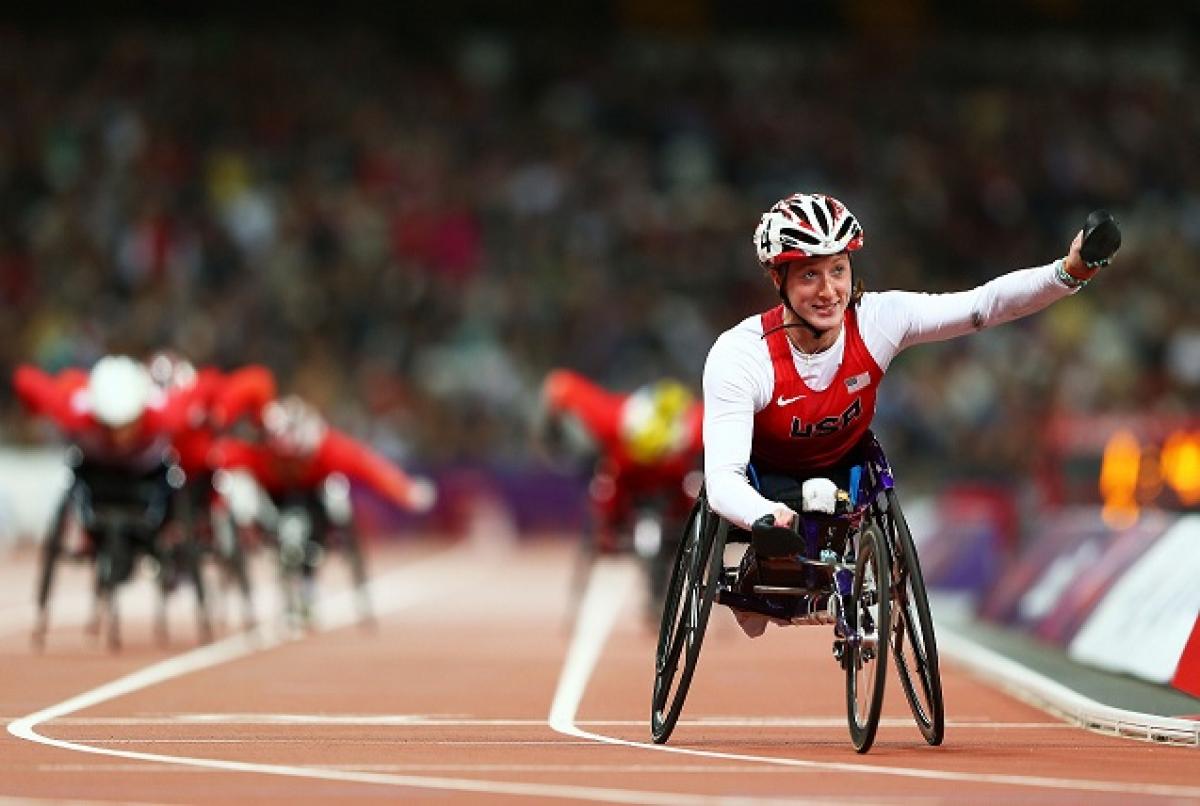Ann Cody: US invites next generation of Paralympians
IPC Governing Board member Ann Cody discusses the latest guidelines regarding athletes with an impairment issued from the US Department of Education. 13 Feb 2013
Tatyana McFadden celebrates the gold in the women's 800m T54 at the London 2012 Paralympic Games.
In the US, a new generation of young people with disabilities will develop sport skills and interests that spark demand for more opportunities in competitive sport and their expectations, rightly, will be high.
In January, the US Department of Education issued guidelines informing nearly 100,000 elementary and secondary schools across the United States they have a legal obligation to provide students with disabilities the opportunity to participate in extracurricular sports in their schools.
In the United States, school-based sports programmes are the most common way in which a student can learn and participate in competitive sports. It is similar to participation in club sports in many other parts of the world.
This is a major breakthrough in the American education system with the potential to impact millions of children (there are 6.5 million students with disabilities in US schools).
If we could reach just 10 per cent of these students, we would eclipse the number of students currently served through community-based Paralympic Sport Clubs. Imagine six to nine-year-olds with disabilities learning the foundational skills of movement, play and sports.
Imagine hundreds of thousands of young people practicing Paralympic sports in their communities and watching their Paralympic heroes on television.
In 2007, BlazeSports America opened an office in Washington, DC to educate policymakers about the importance of access to sport for people with disabilities.
One of our first policy initiatives was to design a strategy to change national policies on sport in schools.
BlazeSports mobilised disability sport and disability rights organisations to tell our elected officials that students with disabilities were being discriminated against in school sports programmes and that something had to be done. Members of the US Congress responded and these new guidelines are the result.
The guidelines concern Section 504 of the Rehabilitation Act of 1973, a law that deals with the rights of disabled people who participate in activities that receive federal dollars. The Department of Education issued the guidelines in response to a 2010 report from the Government Accountability Office finding that students with disabilities participate in sports at a much lower rate than students without disabilities.
This finding was not a surprise to anyone.
A number of high school students with disabilities had previously filed lawsuits in order to compete with their high school sports teams, including Paralympic Champion Tatyana McFadden. It was clear that federal guidelines would be necessary otherwise every athlete with a disability would face the same legal barriers.
The Department of Education’s guidance statement makes it clear that each school – whether an elementary school, high school, or university – must ensure that students with disabilities have equal access to sports based on the following five principles:
• A school district cannot rely on generalisations, prejudices or assumptions about disability. Schools must focus on the ability of the student and modify any programs. They can’t deny a student access to sports based on assumptions about their disability.
• Schools must provide reasonable accommodations. This can include a modification of rules if it does not fundamentally alter the competition. For example, wheelchair tennis players are allowed two bounces before returning the ball and can play with non-disabled players. A track athlete who is deaf can be accommodated with a visual cue such as a flag or flashing light to start the race.
• Schools must provide students with needed aids and services. An example might be glucose testing for a student with diabetes who would normally receive this service during the school day. Schools must provide the same service to allow the student to compete in sports.
• The law requires inclusion whenever possible. Students with disabilities must be given opportunities to compete on existing teams whenever possible.
• Creation of programmes specific for students with disabilities is recommended when inclusion isn’t feasible. This includes sports such as wheelchair basketball when students can’t compete in existing programmes, even with reasonable accommodations and services.
A precursor to the guidelines, the 1990 Americans with Disabilities Act (ADA) requires all public facilities, programs, and services to be accessible and available to people with disabilities.
This public law has mandated access and non-discrimination for over 20 years to public transportation, public housing, buildings, parking lots, sidewalks, schools, sports arenas, locker rooms, restrooms, and field of play areas.
As the new guidelines for schools indicate, access to facilities simply is not enough to guarantee opportunities in sport.
Recognition of sport as a human right, provision of sport programmes by trained sport coaches, and access to transportation and sport facilities are essential elements to growing Paralympic sport.
Until now, the Paralympic Movement worldwide has been built primarily within the ranks of our own determined athletes, coaches, and hard won allies.
We must create new allies and continue to open doors to sport opportunities in the public domain.
This is the way we will reach and engage greater numbers of Paralympic eligible young people in sport.
Ratification and implementation of the UN Convention on the Rights of Persons with Disabilities presents a unique opportunity to grow Paralympic sport. Engaging public officials in shaping policies that favor equality and non-discrimination in sport are critical to this process.
In the US, a new generation of young people with disabilities will develop sport skills and interests that spark demand for more opportunities in competitive sport and their expectations, rightly, will be high.
Young people in Great Britain and all countries that witnessed the London 2012 Paralympic Games will have these same expectations.
We must be prepared to meet them, not where we are, but where they are.
I, for one, am ready to welcome this new generation with open arms.







